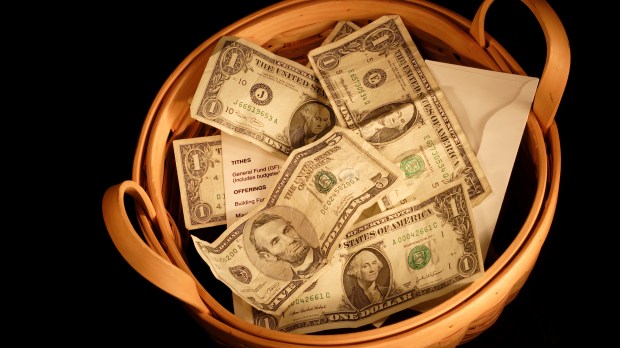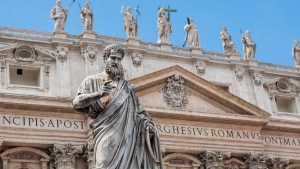Contrary to expectations about church giving, donations to Catholic parishes across the country did not suffer long-term due to the COVID-19 pandemic.
That’s the finding of a study by the Center for Church Management in the Villanova School of Business.
The decrease in church attendance occasioned by the pandemic did not lead to a decrease in parish collections, the center found. Nor was it the case that larger parishes with more financial resources were able to weather the pandemic better than smaller parishes.
“After an initial drop, total parish giving in this sample of parishes increased in year two over pre-pandemic levels and the difference in size of the parish was not statistically significant,” said a summary of the study, released February 1.
As dioceses across the country closed churches in the spring of 2020, and parishioners fulfilled their Sunday obligation by watching Mass on television or internet, there was a 9% drop in church giving. But in the six months beginning in September 2020, parishes saw a return to pre-pandemic levels in donations.
“Surprisingly, total collections for the 989 parishes in this study actually increased in the second year of the pandemic over pre-pandemic levels from $871 million to $891 million,” the study found.
However:
“The number of donors dropped 26% (673,667 to 497,644) in the first six months of the pandemic. The number of donors rebounded slightly since 2020 but remains 16% below pre-pandemic levels. This poses a risk to the long-term sustainability of many parishes.”
Encouraging news
Study authors were encouraged by the finding that annual per-person giving increased 24% in the first year of the pandemic ($1,295 to $1,603). “This is likely a combination of increased generosity in response to the need, larger gifts from the biggest donors, increased giving capacity for those who received stimulus funds, and the benefit of the shift to recurring online giving,” the study said.
An almost equal number of parishes in this study saw collections increase (471, 48%) and decrease (465, 47%), with 6% (58) flat, it said. The distribution followed a typical bell curve as 26% (259) had collections drop over 10% and 28% (273) had collections increase over 10%.
Total overall giving increased for parishes in the Southeast (5%), Southwest (3%) and West (3%) compared to pre-pandemic levels. Total overall giving decreased for parishes in the Northeast (- 2%) and Midwest (-3%) compared to pre-pandemic levels.
But parish size had no statistically significant impact on the change in church giving, the study said. There were an equal number of small, mid-size, and large parishes that did well and did not.
Inflation and church giving
Nevertheless, parishes are feeling the same pinch that most Americans are feeling now, due to inflation. “Despite the overall increase in giving to $891 million, when you adjust for inflation that number becomes $766 million in 2019 dollars, so parishes today have 11% less spending power,” the study said. “This is what economists call the ‘money illusion.’”
Study authors are also concerned about the decrease in the number of people supporting the Church. “These may be people who attended and gave infrequently pre-pandemic, and the COVID-19 closures led them to stop altogether,” they said. “A shrinking base of supporters who are more generous can sustain things in the short-term, but a smaller group of donors will be unable to support the current ministries and infrastructure in the long-run. Without a change in this trend, more parish mergers and closures will be inevitable. There is also the risk that a smaller number of more significant donors could have an outsized influence on the direction of the local Church, which could lead to unfavorable outcomes on several levels.
“Church leaders should consider a personalized and individual outreach to lapsed donors seeking to re-establish a relationship with the parish community,” the report says. “Over time, this could lead to a rekindling of their faith, and as a by-product, support for the mission again. Personalized individual outreach is time-consuming and labor intensive, yet it is also the fundamental evangelizing work of missionary discipleship to which we are all called.”
The full report can be read here.




